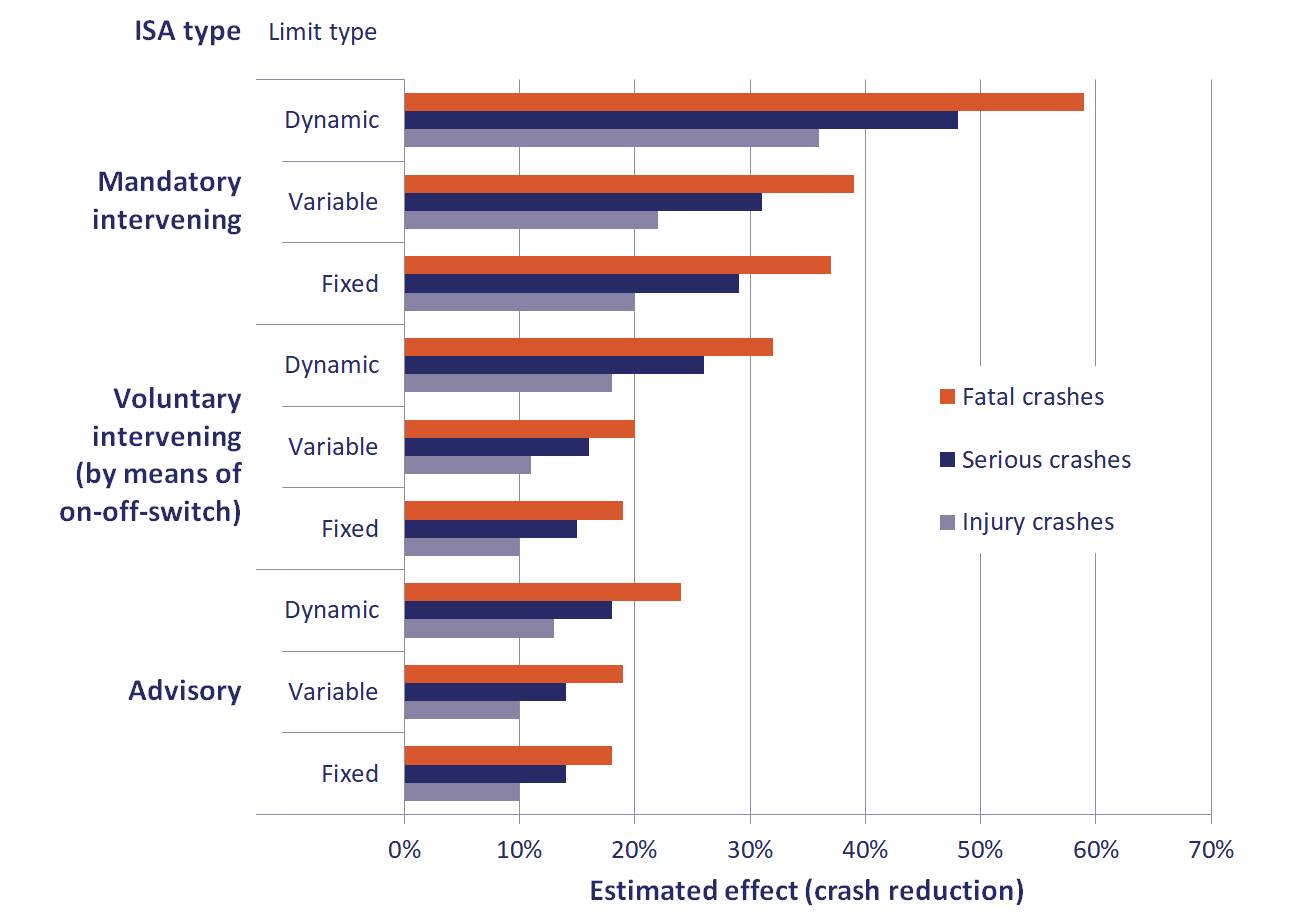Below you will find the list of references that are used in this fact sheet. All sources used can be consulted or retrieved via our Library portal. Here you can also find more literature on this subject.
[1]. European Commission (2016). Advanced driver assistance systems. European Commission, Directorate General for Transport.
[2]. Harms, I.M. & Dekker, G. (2017). ADAS: from owner to user; Insights in the conditions for a breakthrough of Advanced Driver Assistance Systems. Connecting Mobility.
[3]. McDonald, A., Carney, C. & McGehee, D.V. (2018). Vehicle owners' experiences with and reactions to Advanced Driver Assistance Systems. The University of Iowa, Iowa City, Iowa.
[4]. Lai, F., Carsten, O. & Tate, F. (2012). How much benefit does Intelligent Speed Adaptation deliver: An analysis of its potential contribution to safety and environment. In: Accident Analysis & Prevention, vol. 48, p. 63-72.
[5]. Yue, L., Abdel-Aty, M., Wu, Y. & Wang, L. (2018). Assessment of the safety benefits of vehicles’ advanced driver assistance, connectivity and low level automation systems. In: Accident Analysis & Prevention, vol. 117, p. 55-64.
[6]. Schoon, C.C., Reurings, M.C.B. & Huijskens, C.G. (2011). Verkeersveiligheidseffecten in 2020 van maatregelen op het gebied van de veiligheid van personenauto's. Effectschatting van primaire, secundaire en tertiaire veiligheidsvoorzieningen. R-2011-18. SWOV, Leidschendam.
[7]. IIHS (2016). Crashes avoided. Front crash prevention slashes police-reported rear-end crashes. In: Status Report Insurance Institute for Highway Safety, vol. 51, nr. 1.
[8]. Høye, A. (2017). Road safety effects of vehicles crashworthiness, weight, and compatibility. English summary with TØI Report 1580. TØI, Oslo.
[9]. European Commission (2018). Proposal for a REGULATION OF THE EUROPEAN PARLIAMENT AND OF THE COUNCIL on type-approval requirements for motor vehicles and their trailers, and systems, components and separate technical units intended for such vehicles, as regards their general safety and the protection of vehicle occupants and vulnerable road users, amending Regulation (EU) 2018/… and repealing Regulations (EC) No 78/2009, (EC) No 79/2009 and (EC) No 661/2009. COM/2018/286 final - 2018/0145 (COD). European Commission, Brussel.
[10]. Hynd, D., McCarthy, M., Carroll, J., Seidl, M., et al. (2015). Benefit and feasibility of a range of new technologies and unregulated measures in the field of vehicle occupant safety and protection of vulnerable road users : final report. Catalogue number NB-07-14-108-EN-N. European Commission, Directorate-General for Internal Market, Industry, Entrepreneurship and SMEs, Brussel.
[11]. EuroNCAP (2019). De beoordelingen nader verklaard. Safety Assist. Retrieved on 18 February 2019 at https://www.euroncap.com/nl/veiligheid-voertuig/de-beoordelingen-nader-verklaard/safety-assist/.
[12]. Ratingen, M. van (2018). Euro NCAP botsproeven hebben meer dan 78.000 mensen gered. RAI en SWOV. Retrieved on 28 November 2018 at https://veiligonderwegmetdeauto.nl/artikelen/michiel-van-ratingen.
[13]. EU (2008). Aanbeveling van de Commissie betreffende veilige en efficiënte informatie- en communicatiesystemen aan boord van voertuigen: bijwerking van de Europese verklaring inzake beginselen voor de mens-machine-interface (Kennisgeving geschied onder nummer C(2008) 1742). 2008/653/EG. Europese Unie.
[14]. UNECE (2017). Consolidated Resolution on the Construction of Vehicles (R.E.3); Revision 6. Resolution ECE/TRANS/WP.29/78/Rev.6. United Nations, Economic Commission for Europe.
[15]. Davidse, R.J. (2004). Ouderen en ITS: samen sterk(er)? Literatuurstudie naar de toegevoegde waarde van intelligente transportsystemen voor de veiligheid van de oudere automobilist. R-2003-30. SWOV, Leidschendam.
[16]. Dingus, T.A., Guo, F., Lee, S., Antin, J.F., et al. (2016). Driver crash risk factors and prevalence evaluation using naturalistic driving data. In: National Academy of Sciences of the United States of America PNAS. Volume 113, p. 2636-2641.
[17]. Rudin-Brown, C. & Jamson, S. (2013). Behavioural adaptation and road safety: theory, evidence and action. press CRC.
[18]. Smiley, A. (2000). Behavioral adaptation, safety, and intelligent transportation systems. In: Transportation Research Record, vol. 1724, nr. 1, p. 47-51.
[19]. Reed, S. (2017). Adaptive Cruise Control. European Road Safety Decision Support System, developed by the H2020 project SafetyCube. Retrieved on 11-12-2018 at www.roadsafety-dss.eu.
[20]. ETSC (2017). Briefing: Intelligent Speed Assistance (ISA). European Transport Safety Council ETSC. Retrieved on 18 February 2019 at https://etsc.eu/briefing-intelligent-speed-assistance-isa/.
[21]. SARTRE (2004). European drivers and road risk. Project on Social Attitudes to Road Traffic Risk in Europe SARTRE 3. Part 1: report on principal results. Institut National de Recherche sur les Transports et leur Sécurité INRETS, Arcueil, France.
[22]. Aarts, L., Eenink, R. & Weijermars, W. (2014). Opschakelen naar meer verkeersveiligheid; naar maximale verkeersveiligheid voor en door iedereen. R-2014-37. SWOV, Den Haag.
[23]. Carsten, O.M.J. & Tate, F.N. (2005). Intelligent speed adaptation: accident savings and cost–benefit analysis. In: Accident Analysis & Prevention, vol. 37, nr. 3, p. 407-416.
[24]. Vlassenroot, S. (2011). The acceptability of In-vehicle Intelligent Speed Assistance (ISA) Systems: from trial support to public support. TRAIL Thesis Series T2011/8. Trail Research School.
[25]. Bjerre, B. & Thorsson, U. (2008). Is an alcohol ignition interlock programme a useful tool for changing the alcohol and driving habits of drink-drivers? In: Accident Analysis & Prevention, vol. 40, nr. 1, p. 267-273.
[26]. Gustafsson, S. & Forsman, A. (2016). Utvärdering av alkolås efter rattfylleri: enkätstudie [Evaluation of a Swedish alcohol interlock program for drink driving offenders: questionnaire study]. VTI-code: 35-2016; summary in English. VTI, Linköping.
[27]. Jänsch, M. (2017). Lane keeping systems. European Road Safety Decision Support System, developed by the H2020 project SafetyCube. Retrieved on 11-12-2018 at www.roadsafety-dss.eu.
[28]. Saadé, J. (2017). Autonomous Emergency Braking AEB (city, inter-urban). European Road Safety Decision Support System, developed by the H2020 project SafetyCube. Retrieved on 11-12-2018 at www.roadsafety-dss.eu.
[29]. Saadé, J. (2017). Autonomous Emergency Braking AEB (pedestrians & cyclists). European Road Safety Decision Support System, developed by the H2020 project SafetyCube. Retrieved on 11-12-2018 at www.roadsafety-dss.eu.
[30]. Fildes, B., Keall, M., Bos, N., Lie, A., et al. (2015). Effectiveness of low speed autonomous emergency braking in real-world rear-end crashes. In: Accident Analysis & Prevention, vol. 81, p. 24-29.
[31]. Weijer, C. van de (2018). De file is de beste manier om files op te lossen. Retrieved on 18 February 2019 at veiligonderwegmetdeauto.nl/artikelen/carlo-van-de-weijer.
[32]. Vonk, T., Rooijen, T., Hogema, J. van & Feenstra, P. (2007). Do navigation systems improve traffic safety? TNO, Soesterberg.
[33]. Rijksoverheid (2019). Wat is het systeem eCall in mijn auto? Retrieved on 18 February 2019 at https://www.rijksoverheid.nl/onderwerpen/alarmnummer-112/vraag-en-antwoord/wat-is-het-systeem-ecall-in-mijn-auto.
[34]. Ministerie van JenV (2018). Factsheet eCall - automatisch contact met 112 bij een ernstig ongeval. Ministerie van Justitie en Veiligheid.
[35]. Europees Parlement (2015). Verordening (EU) 2015/758 van het Europees parlement en de raad van 29 april 2015 inzake typegoedkeuringseisen voor de uitrol van het op de 112-dienst gebaseerde eCall- boordsysteem en houdende wijziging van Richtlijn 2007/46/EG. Europees Parlement, Brussel.
[36]. Caird, J.K., Chugh, J.S., Wilcox, S. & Dewar, R.E. (1998). A design guideline and evaluation framework to determine the relative safety of in-vehicle intelligent transportation systems for older drivers. Transport Canada, Transportation Development Centre TDC, Montreal, Quebec.
[37]. Hollnagel, E. & Källhammer, J.-E. (2003). Effects of a night vision enhancement system (NVES) on driving: results from a simulator study. In: the Second International Driving Symposium on Human Factors in Driver Assessment, Training and Vehicle Design. Park City, Utah. Iowa City, IA, Public Policy Center, of Iowa, p. 152-157.
[38]. Kampen, B. van, Krop, W. & Schoon, C. (2005 ). Auto’s om veilig mee huis te komen. SWOV & RAI Vereniging, Leidschendam
[39]. Toledo, T. & Lotan, T. (2017). Feedback technologies to young drivers. In: Fisher, D.L., et al. (red.), Handbook of teen and novice drivers. CRC Press, Boca Raton, p. 305-318.
[40]. Hynd, D. & McCarthy, M. (2014). Study on the benefits resulting from the installation of Event Data Recorders: final report. Report prepared for the European Commission, DG MOVE. Published Project Report; PPR 707. Transport Research Laboratory TRL, Crowthorne, Berkshire.


 Figure 2. Most reliable estimation of crash reduction by ISA type (mandatory intervening, voluntary intervening (driver-select) or advisory) and speed limit (fixed, variable or dynamic)
Figure 2. Most reliable estimation of crash reduction by ISA type (mandatory intervening, voluntary intervening (driver-select) or advisory) and speed limit (fixed, variable or dynamic) 
